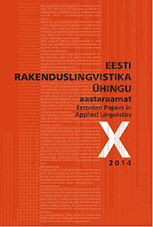Teismeea loovkirjutiste sõnavara ja selle hindamine
TEENAGE VOCABULARY AND ITS ASSESSMENT IN CREATIVE WRITING
Author(s): Halliki Põlda, Anne Uusen, Krista KergeSubject(s): Language and Literature Studies
Published by: Eesti Rakenduslingvistika Ühing (ERÜ)
Keywords: teenage; cognitive development; vocabulary variation and range; lexical sophistication and density; majority language in teaching
Summary/Abstract: Within a study designed to find parameters of educated adult non-philologist L1-writings which give “ideal” benchmarks for assessing high-stakes L1 and L2 writing tests, students’ written vocabulary was targeted in grades 5, 7, 9, and 11 (age 12 to 18) to describe development towards those benchmarks (i.e., higher language cognition; see Hulstijn 2011). 159 students (90% of them native Estonians) were tasked to write an age-appropriate argumentative text on individual and social values. All writings (see table 1) were holistically assessed by the participants’ mother tongue teachers and then analyzed individually for their LFP (lexical profile), measuring the frequency range of all tokens (Laufer, Nation 1995, Meara 2005); their LS (lexical sophistication), measuring the percentage of advanced tokens (see Laufer, Nation 1995); the Uber, Guiraud, and Advanced Guiraud indices, measuring the diversity of general and advanced vocabulary (van Hout, Vermeer 2007, Guiraud 1960, Daller et al. 2003); and the LD (lexical density), showing the proportion of content words to function words (Ure 1971). No significant difference was found between the vocabulary of grades 5 and 7, although individual values of parameters of the strongest writings may be up to ten times higher than those of the weakest ones. Differences between grades 9 and 11 were quite large and all statistically significant. From grade 5 to 11, variation of general vocabulary grows by 1.6 times and that of advanced vocabulary two times; the amount of sophisticated lexis grows by three times. The writings of the few non-native participants (80% of them being bilingual also at home) were not typical of L2. The text length and vocabulary of this group did not differ from those of their age peers using L1. The lexical sophistication of this group was twice as big (17) as that of L2-speakers who had passed a C1-test (9.6; see Alp el al. 2013). There is an obvious need to test non-native writing in Estonian comparatively in two local school systems (with Russian or Estonian as the language of instruction). As supposed, teachers assessing writing holistically were not able to take into account vocabulary parameters. In grade 5, ratings correlated significantly with Guiraud; in grade 11, there was a weak significant correlation between ratings and advanced vocabulary measures. Despite having better late vocabulary (Figure 5), boys’ ratings were significantly lower. This seems to argue in favour of partial computer-scoring.
Journal: Eesti Rakenduslingvistika Ühingu aastaraamat
- Issue Year: 2014
- Issue No: 10
- Page Range: 157-175
- Page Count: 19
- Language: Estonian

